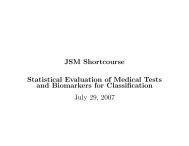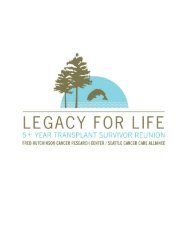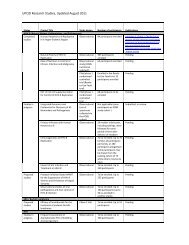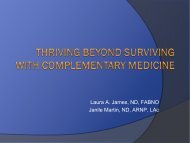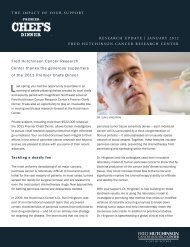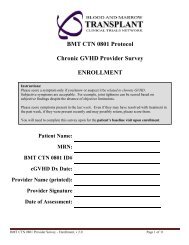Summer Undergraduate Research Program - Fred Hutchinson ...
Summer Undergraduate Research Program - Fred Hutchinson ...
Summer Undergraduate Research Program - Fred Hutchinson ...
You also want an ePaper? Increase the reach of your titles
YUMPU automatically turns print PDFs into web optimized ePapers that Google loves.
QUICK TIPS<br />
(--THIS SECTION DOES NO<br />
This PowerPoint template requires b<br />
(version 2007 or newer) skills. Below<br />
commonly asked questions specific t<br />
If you are using an older version of P<br />
template features may not work pro<br />
Nancy Liu1 , Fionnuala Morrish2 , and David Hockenbery2 Metabolic Flexibility in Triple Negative Breast Cancer Cell Lines<br />
IDE<br />
T PRINT--)<br />
uces a 36”x48”<br />
valuable time<br />
aphics.<br />
1 Swarthmore College, Swarthmore, PA; 2 <strong>Fred</strong> <strong>Hutchinson</strong> Cancer <strong>Research</strong> Center, Seattle, WA<br />
hen send it to<br />
um quality, same<br />
Using the templa<br />
miR375 ANALYSIS LACTATE FLUX<br />
Verifying the quality of your graph<br />
Go to the VIEW menu and click on ZO<br />
preferred magnification. This templa<br />
the size of the final poster. All text a<br />
be printed at 100% their size. To see<br />
poster will look like when printed, s<br />
100% and evaluate the quality of all<br />
before you submit your poster for pr<br />
Lactate Dehydrogenase Assay<br />
In Silico method of analysis<br />
STAT3 EXPRESSION<br />
Method: Assay for STAT3 and p-STAT3 in MCF7 (receptor positive) and<br />
BT549 (triple negative) breast cancer cell lines<br />
Cells lysed and protein quantified<br />
Coomassie stain for protein verification<br />
Tubulin loading control<br />
Western analysis and protein detection<br />
INTRODUCTION<br />
Triple negative breast cancer cell lines have no estrogen receptor (ER),<br />
progesterone receptor (PR) or human epidermal growth factor receptor 2<br />
(HER2) compared to receptor positive cell lines. Triple negative breast<br />
cancers often have limited treatment options since hormone therapies that<br />
target these receptors are ineffective. Exploiting the metabolic differences<br />
in triple negative breast cancer cell lines may elucidate new possible<br />
targets for therapy.<br />
als that will<br />
process and<br />
tions.<br />
eb browser).<br />
Using the placeholders<br />
To add text to this template click in<br />
placeholder and type in or paste you<br />
a placeholder, click on it once (to se<br />
your cursor on its frame and your cu<br />
to this symbol: Then, click onc<br />
its new location where you can resiz<br />
Additional placeholders can be foun<br />
side of this template.<br />
Modifying the layout<br />
This template has four<br />
different column layouts.<br />
Right-click your mouse<br />
on the background and<br />
click on “Layout” to see<br />
the layout options.<br />
The columns in the provided layouts<br />
cannot be moved but advanced user<br />
layout by going to VIEW and then SL<br />
2012 Best Poster Award<br />
Expression of STAT3<br />
BT549 MCF7<br />
1ug 2ug 4ug 1ug 2ug 8ug<br />
Central Carbon Metabolism<br />
nted poster call<br />
.649.3004<br />
Method: To find the predicted and validated targets of miR375 and the<br />
associated pathways, in silico analysis tools were used, including<br />
miRWalk, GSEA, protein strings, and NCI-60 z-score analysis data.<br />
ers<br />
α-‐tubulin<br />
60KDa<br />
Normalized LDH5<br />
1.2<br />
1<br />
0.8<br />
0.6<br />
0.4<br />
0.2<br />
0<br />
to add new<br />
eholder onto<br />
to edit.<br />
BT549 MCF7<br />
1ug 2ug 1ug 2ug<br />
Image courtesy of Fionnuala Morrish<br />
α-‐STAT3<br />
85KDa<br />
der placeholder<br />
ction header.<br />
ics or concepts<br />
111<br />
BT474<br />
lactate<br />
(150ug)<br />
BT474<br />
(150ug)<br />
BT474<br />
lactate<br />
(80ug)<br />
Control BT474<br />
(80ug)<br />
Past studies have found that triple negative breast cancer cells have a<br />
unique metabolic profile and a low OCR/ECAR ratio compared to receptor<br />
positive cancer cell lines. This phenotype is related to the expression of<br />
genes in central carbon metabolism, such as lactate dehydrogenase<br />
(LDHA, LDHB), pyruvate kinase (PDK1), and the monocarboxylic acid<br />
transporter (SLC16A1). Potential candidates for the transcriptional<br />
regulation of these genes include STAT3 and miR375.<br />
Method: Treat BT549 and BT474 (receptor positive) cell lines with lactate<br />
and observe metabolic reprogramming with lactate dehydrogenase activity.<br />
Results: BT474 cell lines may increase expression of skeletal LDH after<br />
Results: STAT3 is potentially upregulated in BT549 cell lines compared to<br />
MCF7 cell lines. Levels of p-STAT3 require 20ug-40ug of protein to be<br />
detected (not shown).<br />
lactate treatment.<br />
older to the<br />
DISCUSSION<br />
Results: miR375 regulates many pathways that may explain the differing<br />
bioenergetic phenotype between triple negative and receptor positive breast<br />
cancer cells. Many putative metabolic pathways have not been studied and<br />
should be exploited in the future.<br />
miR375 EXPRESSION<br />
Importing text and graphics from e<br />
TEXT: Paste or type your text into a<br />
placeholder or drag in a new placeh<br />
left side of the template. Move it an<br />
needed.<br />
PHOTOS: Drag in a picture placehold<br />
click in it and insert a photo from th<br />
TABLES: You can copy and paste a ta<br />
external document onto this poster<br />
adjust the way the text fits within t<br />
table that has been pasted, right-cli<br />
click FORMAT SHAPE then click on T<br />
change the INTERNAL MARGIN values<br />
Differential expression of STAT3 and miR375 between receptor positive<br />
and triple negative cell lines suggest that they play a role in the unique<br />
metabolic phenotype of triple negative cells.<br />
PLAG1<br />
2<br />
1.5<br />
1<br />
All results were preliminary and replicates should be conducted, as well as<br />
an expansion of the experiments on different receptor positive or triple<br />
negative cell lines. Possible further experiments should determine the<br />
mechanism of the lactate metabolic switch as well as whether giving a<br />
lactate holiday will be able to reset this switch. Experiments<br />
overexpressing miR375 in triple negative breast cancer cell lines will<br />
explore results of the in silico miR375 analysis and elucidate the role of<br />
miR375 in metabolic reprogramming.<br />
0.5<br />
0<br />
your poster, size<br />
cture to the<br />
-‐0.5<br />
Average Z score<br />
-‐1<br />
-‐1.5<br />
Image courtesy of Fionnuala Morrish<br />
ACKNOWLEDGEMENTS<br />
Method: Analysis of CellMiner miRNA data to determine differential<br />
expression of miR375 in receptor positive (MCF7, T47D) with triple<br />
negative (HS578T, BT549, MDAMB231) cell lines.<br />
OBJECTIVES<br />
Modifying the color scheme<br />
To change the color scheme of this t<br />
the “Design” menu and click on “Co<br />
choose from the provide color comb<br />
can create your own.<br />
Thank you to Fionnuala Morrish, Kusum Chawla, Cori Abicoff, Li Huang,<br />
Daciana Margienteau, and David Hockenbery for hosting me this summer<br />
and for their guidance and support.<br />
Result: miR375 is down regulated in all triple negative cancer cell lines<br />
analyzed compared to receptor positive lines. This data has been confirmed<br />
by an independent analysis of OSU and Agilent Human miRNA V2<br />
(NCI60 data analysis tools, Reference: Reinhold WC, Sunshine M, Liu H,<br />
Varma S, Kohn KW, Morris J, Doroshow J, and Pommier Y. 2012)<br />
To determine the phosphorylation of STAT3 in receptor positive and triple<br />
negative breast cancer cell lines.<br />
Funding for this project was provided by Seattle Cancer Consortium Breast<br />
SPORE NIH/NCI P50 CA 138293-02. The <strong>Summer</strong> <strong>Undergraduate</strong><br />
<strong>Research</strong> <strong>Program</strong> is supported in part by the Cancer Center Support Grant<br />
(CCSG) CURE Supplement: 3 P30 CA015704-38S1.<br />
To perform an in silico analysis of miR375 expression in receptor positive<br />
and triple negative breast cancer cell lines and predict the consequences of<br />
downregulating miR375 on downstream signaling and metabolic pathways.<br />
© 2012 PosterPresenta.ons.com<br />
2117 Fourth Street , Unit C<br />
Berkeley CA 94710<br />
posterpresenter@gmail.com<br />
PLAG1 is a transcription factor differentially up regulated in triple<br />
negative cells and acts as a proto-oncogene. Fatty acid combustion and<br />
glucose utilization pathways are also associated with miR375 expression.<br />
Reference: CellMiner: A Web-Based Suite of Genomic and Pharmacologic<br />
Tools to Explore Transcript and Drug Patterns in the NCI-60 Cell Line Set<br />
Cancer Res 72:3499-3511. URL:<br />
http://discover.nci.nih.gov/cellminer/analysis.do).<br />
To determine whether a lactate treatment can change the metabolism of<br />
receptor positive and triple negative breast cancer cell lines by analysis of<br />
lactate dehydrogenase enzyme (LDH) isoenzymes.<br />
RESEARCH POSTER PRESENTATION DESIGN © 2012<br />
www.PosterPresentations.com<br />
ur Facebook page.<br />
lick on the FB icon.




